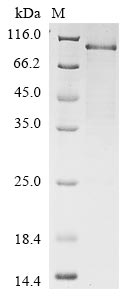CUSABIO generated the recombinant human nuclear factor erythroid 2-related factor 2 (NFE2L2) using the E.coli expression system. The NFE2L2 coding sequence (1-605aa) was synthesized and subcloned into an expression vector with the N-terminal 6xHis-tag gene. E.coli cells were stably co-transfected with the recombinant expression vector containing the targeted gene and then induced for protein expression under certain culture conditions. The recombinant human NFE2L2 protein was extracted from the cell lysate and purified through affinity chromatography. Its purity is over 85% as assessed by SDS-PAGE.
NFE2L2, also called NRF2, is a transcription factor with a basic leucine zipper structure that plays a crucial role in cellular responses to oxidative stress and maintaining redox homeostasis in the body [1]. NFE2L2 has been related to the prognosis of many cancers, including lung cancer [2]. Studies have shown that NFE2L2 modulates chaperone-mediated autophagy, which is essential for cellular homeostasis [3]. Additionally, NFE2L2 activation has been linked to protecting cells from oxidative stress-induced damage, such as in the case of arsenic trioxide exposure [4].
Genetic analyses have revealed that NFE2L2 mutations or dysregulation are found in human cancers, indicating its potential role in tumorigenesis [2]. Furthermore, NFE2L2 has been associated with various diseases, such as Parkinson's disease, where a functional haplotype in the NFE2L2 gene promoter is linked to a decreased risk and delayed onset of the disease [5]. In diabetes, NFE2L2 activation has been correlated with changes in pancreatic cell function, including altered insulin secretion and proliferation [6].
References:
[1] Q. Ju, X. Li, H. Zhang, S. Yan, Y. Liu, & Y. Zhao, Nfe2l2 is a potential prognostic biomarker and is correlated with immune infiltration in brain lower grade glioma: a pan-cancer analysis, Oxidative Medicine and Cellular Longevity, vol. 2020, p. 1-26, 2020. https://doi.org/10.1155/2020/3580719
[2] Z. Qian, T. Zhou, C. Gurguis, X. Xu, Q. Wen, J. Lvet al., Nuclear factor, erythroid 2-like 2-associated molecular signature predicts lung cancer survival, Scientific Reports, vol. 5, no. 1, 2015. https://doi.org/10.1038/srep16889
[3] M. Pajares, A. Rojo, E. Arias, A. Díaz-Carretero, A. Cuervo, & A. Cuadrado, Transcription factor nfe2l2/nrf2 modulates chaperone-mediated autophagy through the regulation of lamp2a, Autophagy, vol. 14, no. 8, p. 1310-1322, 2018. https://doi.org/10.1080/15548627.2018.1474992
[4] L. Zhong, H. Hao, D. Chen, Q. Hou, Z. Zhu, W. Heet al., Arsenic trioxide inhibits the differentiation of fibroblasts to myofibroblasts through nuclear factor erythroid 2‐like 2 (nfe2l2) protein and the smad2/3 pathway, Journal of Cellular Physiology, vol. 234, no. 3, p. 2606-2617, 2018. https://doi.org/10.1002/jcp.27073
[5] I. Lastres‐Becker, Á. García-Yagüe, R. Scannevin, M. Casarejos, S. Kügler, A. Rábanoet al., Repurposing the nrf2 activator dimethyl fumarate as therapy against synucleinopathy in parkinson's disease, Antioxidants & Redox Signaling, vol. 25, no. 2, p. 61-77, 2016. https://doi.org/10.1089/ars.2015.6549
[6] E. Marques, E. Formato, W. Liang, E. Leonard, & A. Timme‐Laragy, Relationships between type 2 diabetes, cell dysfunction, and redox signaling: a meta‐analysis of single‐cell gene expression of human pancreatic α‐ and β‐cells, Journal of Diabetes, vol. 14, no. 1, p. 34-51, 2021. https://doi.org/10.1111/1753-0407.13236






